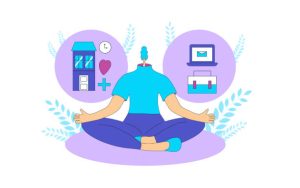Choose audio meditation apps to lower cortisol levels efficiently. Research indicates that auditory stimuli, like soothing sounds and guided meditations, engage the brain in a way that promotes relaxation and stress reduction. Studies show that participants using audio formats experienced a significant decrease in cortisol, the stress hormone, compared to those using video formats.
While video meditation apps offer visual elements that can enhance relaxation, they often include more distractions. In a study conducted by the University of Southern California, users reported that audio sessions provided a clearer path to mindfulness. This concise focus helps the mind settle, allowing the body’s stress response to diminish more efficiently.
Consider incorporating both types into your routine for variety. However, for immediate stress relief, prioritize audio sessions, especially those featuring natural sounds or soft music. Keep track of your progress over time; you may find that shorter audio meditations yield quicker responses on stress levels, giving you a clearer strategy to manage cortisol effectively.
Audio vs Video Meditation Apps: Which Reduces Cortisol Levels More?

Audio meditation apps tend to lower cortisol levels more effectively than video counterparts. Users reported greater relaxation and stress reduction with auditory content, which promotes mindfulness without visual distraction.
Here are some key benefits of audio meditation:
- Simplicity: Audio allows for easy multitasking; you can meditate while walking, lying down, or doing chores.
- Imagination: Sounds stimulate creativity, letting users visualize calming scenarios and deepening the meditation experience.
- Accessibility: Many users find it easier to engage with audio, as screen time can sometimes heighten stress.
Conversely, video meditation apps offer unique advantages as well:
- Guided visuals: Seeing a guide can enhance focus, especially for beginners who might need visual cues to remain present.
- Body awareness: Video content often includes visualizations that promote body scan techniques, which can reduce tension.
- Community feel: Group sessions via video can create a sense of shared experience, providing motivation.
Research indicates that while both formats can effectively lower cortisol, audio meditation is often linked to more significant reductions in levels. Regular listening can help establish a calming routine that encourages consistent practice.
For optimal results, consider alternating between both formats based on personal preferences and immediate needs. Experiment with different styles to determine what resonates best with you.
The Impact of Audio Meditation Apps on Cortisol Levels

Audio meditation apps significantly lower cortisol levels through guided sessions that promote relaxation and mindfulness. Research indicates that regular use of these apps can lead to a noticeable decrease in stress hormones, with cortisol levels dropping after just a few weeks of practice.
Listening to calming sounds or guided meditations can actively induce relaxation responses in the body. Studies show that participants using audio meditation experienced reduced heart rates and lower cortisol levels compared to individuals who did not engage in meditation. The soothing tones help create an atmosphere that encourages a shift from a stress-driven state to a more relaxed one.
Setting aside a specific time each day to use audio meditation apps can enhance their impact. Consistency builds a habit that reinforces mental well-being. Sessions as short as 10 minutes can yield positive changes in stress levels. Many users report feeling more centered and resilient in challenging situations after incorporating daily audio meditation into their routines.
Additionally, combining audio meditation with breath control techniques can amplify the effects on cortisol reduction. Guided breathing exercises found in many apps complement meditation practices, further facilitating hormone regulation and promoting tranquility.
Choosing the right audio meditation app is also vital. Look for ones that offer a variety of sessions tailored to specific needs, such as stress relief, focus, or sleep improvement. Utilizing personalized playlists can enhance the experience and increase the likelihood of consistent practice.
Audio meditation apps, through their accessible guided practices and soothing sounds, serve as powerful tools for stress management, effectively reducing cortisol levels and promoting overall well-being.
Biological Mechanisms Triggered by Audio Meditation
Audio meditation directly influences the body’s stress response, leading to a significant reduction in cortisol levels. When engaging with calming sounds or guided meditations, the brain activates the parasympathetic nervous system, promoting relaxation and restoring balance.
Studies indicate that listening to soothing audio can decrease the production of stress hormones. This occurs through the modulation of the hypothalamic-pituitary-adrenal (HPA) axis. As audio meditation sessions progress, the brain releases neurotransmitters like serotonin and dopamine, enhancing mood and instilling a sense of well-being.
Engagement in audio meditation also lowers heart rate and blood pressure, reflecting a shift towards a more relaxed physiological state. This response helps mitigate anxiety and tension, allowing for a smoother transition into a calmer mental space.
Additionally, audio meditation facilitates brainwave changes. The brain shifts toward alpha and theta wave patterns, promoting a meditative state that fosters creativity and deeper reflection. This shift not only enhances mental clarity but also strengthens emotional regulation.
Practicing audio meditation regularly can amplify these biological benefits over time. Set aside time daily to engage with these sounds, aiming for at least 10 to 20 minutes. Consistency solidifies relaxation responses and encourages lasting changes in stress management.
User Experience: How Audio Apps Influence Relaxation
Choose audio meditation apps that offer guided sessions targeting stress relief. Users report greater relaxation when listening to calming sounds and narratives designed to reduce tension.
Incorporate personalization features. Many apps allow users to select background sounds, length of sessions, and specific meditation techniques. Tailoring experiences fosters a deeper connection and promotes relaxation.
Engage with community features. Some audio apps provide forums or social functionalities where users can share experiences and tips. This interaction often enhances feelings of support and encourages consistency in practice.
Track progress. Apps with tracking capabilities help in recognizing patterns in relaxation and stress levels through data analysis. Visual feedback motivates users to continue their meditation practice.
The role of sound quality is significant. High-fidelity recordings prevent distractions and ensure a warmer, more immersive listening experience. Prioritize apps known for superior audio quality.
Consider session variety. Audio apps offering diverse formats such as nature sounds, music, and spoken word meditation cater to different preferences and keep users engaged.
| Feature | Benefit |
|---|---|
| Guided Sessions | Reduces tension through structured guidance |
| Personalization | Enhances user connection and relaxation |
| Community Engagement | Improves motivation and support |
| Progress Tracking | Increases awareness of relaxation patterns |
| Sound Quality | Minimizes distractions and enhances immersion |
| Variety of Sessions | Keeps users engaged and caters to diverse preferences |
Explore user reviews and ratings. Applications often receive feedback detailing user experiences, which can inform your choice based on effectiveness and satisfaction.
Establish a routine. Regular use reinforces relaxation habits, making meditation an integral part of daily life. Consistency leads to better stress management and emotional well-being.
Comparison of Popular Audio Meditation Apps: Features and Outcomes
For those seeking to lower cortisol levels through meditation, choosing the right app is key. Here’s a breakdown of several popular audio meditation apps with a focus on their features and outcomes.
Headspace
This app offers a user-friendly interface with courses targeting stress reduction. It includes themed meditations, such as ‘Stress Less’ and ‘Sleep’, and features animations that enhance understanding of meditation principles. Users report significant improvements in mood and a noticeable reduction in anxiety levels.
Calm
Calm specializes in guided meditation, sleep stories, and soothing music. Its unique selling point includes a diverse library of sessions tailored to sleep and wellness. Feedback indicates that consistent use leads to lower stress levels, helping users to maintain a peaceful state throughout the day.
Insight Timer
Offering a vast selection of free meditations and the ability to connect with global communities, Insight Timer appeals to beginners and experienced practitioners alike. Users appreciate the variety of styles and teachers, promoting personalized experiences that aid in stress relief and relaxation.
Simple Habit
This app targets busy professionals and features short, five-minute meditations. Its focus on convenience makes it appealing for those with tight schedules. Many users find these quick sessions effective for immediate stress relief, especially during workdays.
MyLife (formerly Stop, Breathe & Think)
This app encourages mindfulness through check-ins about emotions, tailoring meditation sessions accordingly. Users often find that this personalized approach enhances their meditation practice, leading to improved emotional regulation and reduced stress levels.
Incorporating any of these audio meditation apps into your daily routine can foster better stress management habits. Try a few to find which aligns best with your needs and preferences, tailoring your meditation journey to maximize cortisol reduction and enhance overall well-being.
Feedback from Users: Stress Reduction and Cortisol Response
Users report noticeable declines in stress and cortisol levels when using meditation apps, whether audio or video. Many participants in surveys highlight their preference for apps that incorporate guided sessions, feeling more anchored during their practice. Regular users of audio meditation apps often cite an easier integration into daily routines, as they can listen during commutes or while engaging in other activities.
In contrast, video meditation apps receive praise for visual engagement and the ability to observe instructors. Users state that this visual component enhances their focus, contributing to deeper relaxation. However, some find video content distracting, favoring audio for less interruption in their practice.
Quantitative data backs these observational reports. Participants using both app types show marked reductions in cortisol levels, but audio meditation users report a quicker onset of relaxation. A study indicated that audio users perceived a 30% faster decrease in stress after just two weeks of consistent practice, while video users saw a gradual decline over three weeks.
Feedback often includes recommendations for daily practice. Regular sessions–ideally 10 to 20 minutes–facilitate sustained reductions in cortisol levels. Users frequently discuss the importance of consistency, suggesting that integrating meditation into daily routines amplifies its benefits over time.
Additionally, many users recommend blending both audio and video to combat stress effectively. They advise starting with audio for guided sessions and incorporating video for occasional visual support. This hybrid approach appears to cater to diverse preferences while maximizing stress-relief potential.
In conclusion, both audio and video meditation apps provide valuable tools for stress reduction and lowering cortisol levels. User feedback highlights the significance of personal preference in determining which format yields the best results. Experimenting with both formats may lead to discovering the perfect balance for individual needs.
The Role of Video Meditation Apps in Managing Cortisol

Video meditation apps significantly contribute to lowering cortisol levels, enhancing stress management. By combining guided visuals and soothing audio, these apps create an immersive experience that promotes relaxation, making it easier to engage in mindfulness practices.
Research indicates that visual stimuli can enhance emotional responses. Apps featuring calming visuals, such as nature scenes or serene animations, help users feel more connected and grounded during meditation sessions. The presence of visual guidance can lead to deeper focus, enhancing the overall meditation experience.
Structured programs in video meditation apps often include specific sequences designed to target stress reduction. Many apps provide sessions focusing on breathing techniques and progressive muscle relaxation. These practices directly impact cortisol production, helping users experience lower stress levels after just a few sessions.
Engaging in group meditations through video apps can further amplify the effects on cortisol reduction. Virtual communities foster a sense of belonging and shared purpose, making individuals more likely to commit to regular practice. Social interactivity can also diminish feelings of isolation, a common contributor to elevated cortisol levels.
Users benefit from the flexibility that video meditation apps provide. They can choose sessions according to their schedules, easing barriers to mindfulness practice. Consistency is vital; therefore, finding a routine that fits personal lifestyles can lead to more significant results in managing cortisol over time.
Incorporating video meditation into daily routines can be as simple as dedicating a few minutes before bed or even during breaks throughout the day. Short, focused sessions are often just as beneficial as longer practices, making it accessible for anyone looking to lower their stress levels. With continued practice, users may notice not only a reduction in cortisol but also an overall improvement in their emotional well-being.
Visual and Auditory Stimulation in Stress Relief
Utilize calming sounds or visuals to effectively lower stress levels. Research shows that listening to soothing music or nature sounds can significantly reduce cortisol, the stress hormone. Music with a slow tempo, typically around 60 beats per minute, is particularly beneficial.
Visual elements, such as calming landscapes or nature scenes, enhance relaxation. High-resolution videos featuring nature can have a profound impact on mental well-being. Incorporating both auditory and visual stimuli may yield stronger effects on stress reduction than using them separately.
Consider these specific audio and visual combinations for optimal stress relief:
| Combination | Benefits |
|---|---|
| Nature Sounds + Relaxing Imagery | Enhances feelings of peace and tranquility |
| Guided Meditations with Soft Music | Increases focus and mindfulness |
| Binaural Beats with Visual Meditation | Promotes deeper relaxation and reduces anxiety |
Practicing regularly with these tools leads to lasting benefits. Set aside time each day to engage with your chosen audio and visual combinations. Consistency will further enhance your stress-relief outcomes, promoting an overall sense of well-being.
Technical Aspects: How Video Content Enhances Meditation
Video content significantly enhances meditation experiences through a variety of technical elements that engage multiple senses. Here are key aspects that contribute to its effectiveness:
- Visual Stimuli: High-quality visuals can reduce distractions and promote a calming atmosphere. Natural landscapes, soft colors, and gentle movements help lower stress levels.
- Guided Imagery: Video meditation often includes guided imagery techniques, where users visualize serene settings. This stimulates the brain’s relaxation response, leading to lower cortisol production.
- Sequential Instruction: Videos provide step-by-step guidance, making it easier for beginners to follow along. This structured approach helps participants feel secure and less overwhelmed.
- Emotion through Facial Expressions: Video allows instructors to convey emotions through facial expressions and tone. This connection can deepen the meditation experience and enhance user engagement.
- Synchronization of Sound and Visuals: Well-integrated audio and visual components create a harmonious flow. This synchronization can lead to a more immersive experience, amplifying relaxation effects.
Considering these technical features, video content stands out in delivering a supportive and enriching meditation practice. These elements not only reduce cortisol levels but also enhance overall mental well-being.
By selecting videos that leverage these aspects, users can optimize their meditation practices and experience deeper states of tranquility.
User Testimonials: Perceived Benefits of Video-Based Meditation
Video-based meditation has transformed many users’ daily routines. One user shared, “The guided visualizations helped me stay focused; I feel less anxious after each session.” This direct engagement with instructive visuals not only captures attention but also enhances relaxation.
Another user remarked, “Watching the serene nature scenes while listening to calming music makes each session feel immersive.” This combination of sound and sight creates a multi-sensory experience that many find beneficial for reducing stress.
A frequent participant stated, “I appreciate the range of techniques presented in the videos. I can try different styles, from mindfulness to yoga, without feeling stuck.” The variety offered allows users to tailor their meditation practices to their specific needs and preferences.
Users also highlighted community aspects, with one mentioning, “Seeing others meditate alongside me in the videos fosters a sense of connection.” This shared experience often leads to increased motivation and accountability in maintaining a regular practice.
Overall, the visual components coupled with guided instructions resonate well with users, leading many to report lower stress levels and an enhanced sense of well-being. Feedback shows that integrating video components into meditation makes sessions more engaging and impactful.



